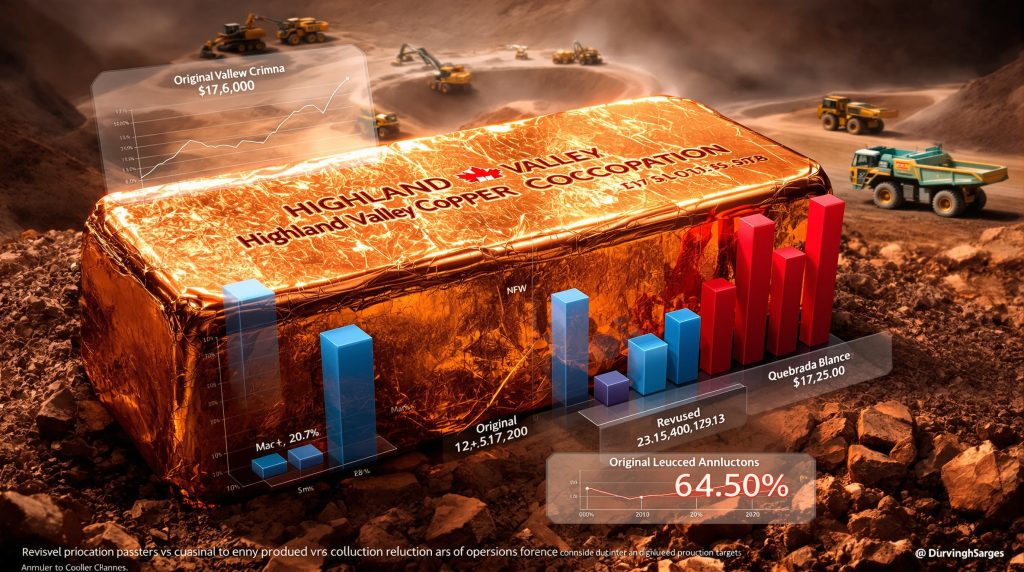Teck Resources Revises Copper Production Outlook: Operational Challenges and Market Implications
Teck Resources has significantly reduced its copper production forecasts for 2025 and beyond, pointing to operational challenges at key mining assets. The company's revised guidance reflects a combination of technical issues, grade variations, and maintenance requirements that have necessitated these adjustments. Understanding these factors provides insight into both Teck's strategic position and broader industry dynamics affecting global copper supply forecast.
The Scale of the Reduction
- Original 2025 guidance: 470,000-525,000 tonnes of copper
- Revised 2025 guidance: 415,000-465,000 tonnes of copper
- Reduction percentage: Approximately 11-12% decrease in expected output
This substantial reduction comes at a time when copper markets remain tight and demand forecasts continue to strengthen, creating significant implications for both the company and the broader market.
What Specific Issues Are Affecting Highland Valley Copper?
Highland Valley Copper (HVC), Teck's flagship Canadian copper operation, has encountered several operational challenges that contributed significantly to the overall guidance reduction.
Operational Challenges at HVC
- Production guidance lowered to 120,000-130,000 tonnes from previous 135,000-150,000 tonnes
- Unplanned maintenance requirements during Q3 2025 disrupted production flow
- Lower ore grades encountered in current mining zones than geological models predicted
- Impact extends into 2026 with continued downward revisions to production targets
According to reporting from The Canadian Press via BNN Bloomberg, these issues stem from both technical challenges and geological factors that proved more complex than initially modeled.
Technical and Geological Factors
The core technical challenges at Highland Valley Copper revolve around ore grade variability and maintenance issues that have ripple effects throughout the operation:
- Mill throughput constraints affecting processing capacity
- Grade variability in certain mining zones exceeding expected parameters
- Extended equipment downtime affecting overall operational efficiency
- Weather-related challenges impacting site conditions and accessibility
Mining engineers familiar with large-scale copper operations note that such variability is becoming increasingly common in mature mining districts, where early models sometimes fail to capture the full complexity of ore body characteristics.
How Are Quebrada Blanca Operations Contributing to the Guidance Reduction?
Teck's Quebrada Blanca (QB) operation in Chile represents another significant contributor to the company's production guidance reduction. This major asset has faced its own set of operational hurdles that have necessitated substantial revisions to near-term production expectations.
QB Mine Performance Issues
- Revised guidance for QB: 170,000-190,000 tonnes, down from 210,000-230,000 tonnes
- Tailings management complications requiring additional engineering solutions
- Commissioning challenges with certain processing circuits affecting recovery rates
- Throughput limitations during ramp-up phase of expansion projects
These technical challenges highlight the complexity of bringing large-scale copper projects to full operational capacity, particularly in regions with challenging topography and infrastructure limitations.
Long-term Implications for QB
The production challenges at Quebrada Blanca extend beyond the immediate timeframe, affecting multi-year planning:
- 2026 production now projected at 200,000-235,000 tonnes (previously 280,000-310,000 tonnes)
- 2027 outlook adjusted to 240,000-275,000 tonnes
- 2028 projection set at 220,000-255,000 tonnes
- Gradual improvement trajectory expected as operational issues are resolved
This extended impact underscores the complex nature of resolving operational challenges at large-scale mining operations, where solutions often require significant time and capital investment to fully implement.
What Market Factors Are Offsetting the Production Challenges?
Despite the operational challenges, several market dynamics are working to partially offset the financial impact of reduced production volumes for Teck and other producers facing similar constraints.
Copper Price Environment
- Average copper price in Q3 2025: $4.44/lb
- Strong pricing partially mitigating revenue impact of lower production volumes
- Price support from global supply constraints across major copper producers
- Market fundamentals remain favorable despite operational setbacks
According to market analysts, the tight supply-demand balance in copper markets continues to support price levels that help offset volume reductions. The positive copper price outlook has been observed across multiple commodities in 2025, including precious metals, with gold surging to record highs above US$4,000 per ounce as reported by Reuters.
Supply-Demand Dynamics
| Factor | Current Status | Market Impact |
|---|---|---|
| Global Copper Supply | Constrained by industry-wide challenges | Supportive of higher prices |
| Demand Outlook | Strong growth in renewable energy and EV sectors | Increasing pressure on available supply |
| Inventory Levels | Multi-year lows across major exchanges | Creating price premium for immediate delivery |
| Production Disruptions | Affecting multiple major producers | Amplifying market tightness |
This table highlights how broader market factors are creating a supportive price environment despite production challenges. The Grasberg mine incident in Indonesia, where a mudslide resulted in seven casualties and the suspension of operations at a major copper mine, further illustrates the supply-side constraints affecting global copper markets.
How Does This Affect Teck's Strategic Position?
Teck's production guidance revisions come at a critical juncture for the company as it navigates both operational challenges and strategic opportunities in a consolidating mining landscape.
Anglo American Merger Considerations
- Production guidance revisions occurring during ongoing merger process
- Analysts suggest updated guidance may enhance merger appeal for Teck shareholders
- Combined entity would benefit from diversified asset portfolio and risk mitigation
- Integration planning continues despite operational challenges
Industry analysts note that production challenges sometimes accelerate strategic discussions, as companies seek to mitigate risk through portfolio diversification and operational synergies.
Long-term Growth Strategy
- Focus on addressing operational issues while maintaining development pipeline
- Continued investment in technological solutions to improve recovery and efficiency
- Exploration activities to identify higher-grade zones for future mining phases
- Strategic partnerships to enhance operational capabilities and market position
Teck's approach to addressing current challenges while maintaining focus on long-term growth opportunities reflects a balanced strategy that acknowledges both immediate operational needs and future market positioning.
What Are the Broader Industry Implications?
Teck's production challenges reflect wider issues affecting copper producers globally, pointing to structural constraints in meeting rising copper demand.
Global Copper Supply Pressures
- Teck's guidance reduction contributes to industry-wide production shortfalls
- Other major producers facing similar geological and operational challenges:
- Freeport McMoRan experiencing grade decline at certain operations
- Codelco addressing productivity issues across Chilean assets
- Industry-wide capex constraints limiting expansion opportunities
The Northern Miner reported that Freeport-McMoRan's Grasberg mine in Indonesia experienced a significant mudslide involving 800,000 tonnes of wet material, resulting in seven worker casualties and suspended operations since September 2025. This incident further highlights the operational risks affecting major copper producers globally.
Market Response and Price Impact
- Immediate copper price strengthening following guidance reduction announcement
- Increased analyst focus on supply-side constraints in price forecasting
- Growing recognition of structural challenges in meeting future copper demand
- Investment community reassessing production growth expectations across sector
These dynamics have created renewed interest in copper-focused investments, particularly as the metal's critical role in energy transition technologies continues to strengthen demand forecasts despite macroeconomic uncertainties.
How Can Teck Address These Production Challenges?
Addressing the operational challenges at both Highland Valley Copper and Quebrada Blanca will require a multi-faceted approach combining technical innovation, operational optimization, and strategic planning.
Technical Solutions and Optimization Strategies
- Implementation of advanced ore sorting technologies to manage grade variability
- Enhanced preventative maintenance programs to reduce unplanned downtime
- Process optimization initiatives to improve recovery rates and throughput
- Digital transformation projects to enhance operational visibility and decision-making
Recent industry developments highlight the increasing role of technology in addressing mining challenges. International Mining reported that Ideon Technologies has entered a five-year partnership with Rio Tinto to deploy its Reveal subsurface intelligence platform across six major operations. This platform integrates data-driven mining operations from multiple sources, including muon tomography (an imaging technique using cosmic ray muons to visualize deep geological structures), to provide high-resolution, multi-dimensional subsurface models.
Operational Excellence Initiatives
- Cross-functional teams focused on addressing specific production bottlenecks
- Benchmarking against industry best practices to identify improvement opportunities
- Enhanced training programs to build technical capabilities among operational teams
- Revised modern mine planning approaches to optimize extraction sequences
Industry experts note that successful mining operations increasingly require a combination of technical expertise and workforce development. As highlighted at the recent CIM Maintenance, Engineering and Reliability/Mine Operators Conference in Calgary, attracting and retaining skilled workers remains a major challenge for Canada's mining sector despite abundant opportunities.
What Does This Mean for Investors and Market Observers?
For investors and market analysts, Teck's production guidance revisions provide important insights into both company-specific dynamics and broader industry trends affecting the copper sector.
Key Performance Indicators to Monitor
- Quarterly production reports for signs of operational improvement
- Unit cost trends as indicator of efficiency gains or persistent challenges
- Capital expenditure allocations for technical solutions and optimization
- Management commentary on timeline for returning to higher production levels
These metrics will provide important signals about Teck's progress in addressing operational challenges and the potential timeline for production recovery.
Investment Considerations
- Short-term production challenges versus long-term asset quality assessment
- Copper price environment as mitigating factor for revenue impact
- Strategic value of Teck's asset portfolio in consolidating copper industry
- Potential for operational improvements to exceed revised guidance
Industry observers note that while production challenges create near-term uncertainty, they can also drive innovation and operational improvements that yield long-term benefits for companies willing to invest in solutions.
FAQ: Understanding Teck's Copper Production Revision
How significant is this production guidance reduction in historical context?
This represents one of the more substantial guidance reductions for Teck in recent years, reflecting both site-specific challenges and industry-wide trends of declining ore grades and increasing operational complexity in mature mining districts.
Will these operational issues affect Teck's other metal production?
The current guidance reduction is specific to copper operations, with zinc, steelmaking coal, and other commodity productions remaining within previously established guidance ranges.
How does this guidance reduction compare to industry peers?
Several major copper producers have faced similar challenges in 2025, with industry-wide production approximately 3-5% below initial forecasts, placing Teck's reduction at the higher end of the industry adjustment range.
What technological investments might help address these challenges?
Advanced analytics, artificial intelligence for predictive maintenance, automated drilling systems, and enhanced recovery technologies represent the most promising solutions for addressing the operational issues affecting production.
Navigating Short-Term Challenges in a Strong Copper Market
Teck Resources' copper production guidance reduction highlights the operational complexities facing major miners in today's environment. While the revised targets represent a significant adjustment to near-term expectations, the strong copper price environment partially offsets the volume impact. The company's focus now turns to implementing technical solutions and operational improvements to address the specific challenges at Highland Valley Copper and Quebrada Blanca operations.
For market observers, these developments underscore the structural challenges in meeting growing global copper demand, potentially supporting a continued strong price environment. For Teck specifically, successfully addressing these operational issues while progressing with strategic initiatives like the Anglo American merger will be critical to maintaining its competitive position in the global copper market.
In the context of broader industry developments, copper producers must navigate a complex landscape that includes not only operational challenges but also evolving regulatory frameworks and growing demand for critical minerals. The Trump administration's recent approval of the 340-kilometer Ambler Road project in Alaska, which will facilitate development of copper, cobalt, gold, and other mineral resources, highlights the strategic importance of copper in national resource strategies. Similarly, China's tightened export controls on rare earths and related materials underscore the geopolitical dimensions of critical mineral supply chains.
Against this backdrop, Teck's efforts to address production challenges while positioning for long-term growth reflect the balancing act required of major miners in today's dynamic market environment.
Looking for the Next Major Mineral Discovery?
Discovery Alert's proprietary Discovery IQ model delivers real-time alerts on significant ASX mineral discoveries, helping investors identify opportunities before the broader market reacts to resource announcements. Explore why major mineral discoveries can lead to substantial market returns by visiting Discovery Alert's dedicated discoveries page and position yourself ahead of the market.




